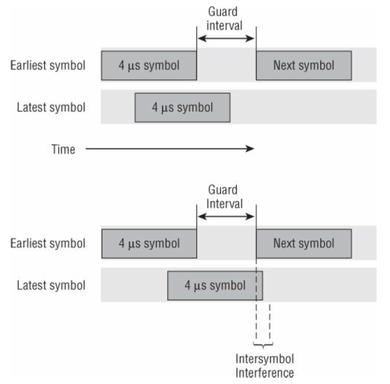Guard Interval (GI)
. . . .
Guard Interval (GI)
- For digital signals, data is modulated onto the carrier signal in bits orcollections of bits called symbols.
- When 802.11a/g radios transmit at 54 Mbps, each OFDM symbol contains 288 bits; 216 of these bits are data, and 72 of the bits are error-correction bits.
- All the data bits of an OFDM symbol are transmitted across the 48 data subcarriers of a 20 MHz non-HT channel.
- 802.11a/g radios use an 800-nanosecond guard interval (GI) between OFDM symbols.
- The guard interval is a period of time between symbols that accommodates the late arrival of symbols over long paths.
- In a multipath environment, symbols travel different paths, and therefore some symbols arrive later.
- A “new” symbol may arrive at a receiver before a “late” symbol has been completely received. This is known as intersymbol interference (ISI) and often results in data corruption.
- Delay spread is the time differential between multiple paths of the same
signal. - Normal delay spread is 50 nanoseconds to 100 nanoseconds, and a maximum delay spread is about 200 nanoseconds.
- The guard interval should be two to four times the length of the delay spread.
- Think of the guard interval as a buffer for the delay spread.
- The normal guard interval is an 800-nanosecond buffer between symbol transmissions.
- As pictured in Figure 18.12, a guard interval will compensate for the delay spread and help prevent intersymbol interference.
- If the guard interval is too short, intersymbol interference can still occur.
- 802.11n also uses an 800-nanosecond guard interval; however, a shorter 400-nanosecond guard interval is optional.
- A shorter guard interval results in a shorter symbol time, which has the effect of
increasing data rates by about 10 percent. - If the optional, shorter 400-nanosecond guard interval is used with an 802.11n radio, throughput will increase; however, the odds of an intersymbol interference
occurrence increases. - If intersymbol interference does indeed occur because of the shorter GI, the result is data corruption.
- If data corruption occurs, layer 2 retransmissions will increase and the throughput will be adversely affected.
- Therefore, a 400-nanosecond guard interval should be used in RF environments without excessive multipath which could cause late symbols to overlap with new symbols.
- If throughput goes down because of a shorter GI setting, the default guard interval setting of 800 nanoseconds should be used instead.
Reference:
Coleman, David D.,Westcott, David A. CWNA: Certified Wireless Network Administrator Official Study Guide: Exam CWNA-106 Wiley.
Coleman, David D.,Westcott, David A. CWNA: Certified Wireless Network Administrator Official Study Guide: Exam CWNA-106 Wiley.
|
|

